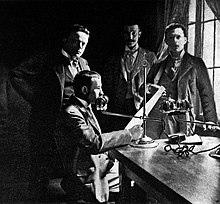Telephone newspaper
A telephone newspaper was a telephone distribution system of the 19th and 20th centuries that provided newspaper content over telephone lines. The telephone newspapers were the first versions of electronic broadcasting and were later replaced by classic broadcasting .
For a long time, remote areas that were initially barely or not at all accessible by aerial broadcasting were made accessible via the so-called wire radio , as radio over the telephone line. One example of this was the Swiss telephone slogan . The Italian service Filodiffusione der Rai is still active today. It developed into an independent service alongside the “normal” radio and is now also broadcast via satellite and the Internet.
development
The theatrophone evolved from an invention by Clément Ader in 1881 ; It was commercialized in 1890 by the Compagnie du Théâtrophone of MM. Marinovitch and Szarvady. The main offer of the theatrophone consisted of theater and opera performances, but it also included five-minute news broadcasts at regular intervals. In 1932 the service was replaced by radio and the phonograph.
Telephone newspapers
Telephone Hirmondo
Telefon Hírmondó , the longest-running telephone newspaper , was founded in Budapest in 1893 by Tivadar Puskás . It was the first independent newspaper to be distributed over the telephone network. The newspaper offered its subscribers news, stock market prices, concerts and language courses. The service continued as a newspaper into the 1920s, and began broadcasting on the radio on December 1, 1925. Both services (both by telephone and radio) were offered in parallel for a while. During the Second World War , the company's telephone network was completely destroyed, resulting in the abandonment of this service.
Electrophones
Founded in 1895, the Electrophone provided live broadcasts of theaters and music shows in the United Kingdom , as well as church services on Sundays. It was technically based on the French theater and ended its transmission in 1926 due to competition from radio.
L'Araldo Telefonico
L'Araldo telefonico (Italian for "The Telephone Messenger") was started in Rome in 1910 , based on the Hírmondó telephone model . It was the first example of Italian broadcasting, and in 1914 it had more than 1,300 subscribers. The service was interrupted by the First World War and started again in 1922 under the name "Fonogiornale". In 1922 the name was changed to "Radioaraldo" and the technology switched from telephone transmission to radio. The Radioaraldo opened its first radio station in Rome. Radioaraldo worked with other private Italian companies to create the URI (Unione Radiofonica Italiana) broadcasting company in 1924. The URI became the EIAR (Ente Italiano Audizioni Radiofoniche) in 1928 and finally the RAI (Radio Audizione Italiane) in 1944 .
Telephone Herald
MM Gillam, a former advertising manager for the New York Herald , discovered the Telefon Hírmondó on a trip to Hungary and acquired the technological rights for America. He founded the United States Telephone Herald Co. in Newark , USA to administer the rights in the individual states. One company received the rights to the state of New Jersey in 1911 and started an issue in Newark . This was unsuccessful and stopped working again in 1912.
Web links
- Description of the Budapest telephone newspaper in the Electrical Review in 1901 (English)
- Telephone newspaper - detailed article at Citizendium (English)
- Radio history (English)
Individual evidence
- ^ Wanted, A Theatrophone . In: The Electrical Engineer . July 5, 1890, p. 4. Retrieved on November 21, 2007.
- ↑ Orologio Dell'Aria, Spettacolo Elettrico: Cosiderazioni Sull'Avvento Della Radio ( Italian ) Archived from the original on October 22, 2007. Retrieved on November 22, 2007.
- ↑ Le Origini Della Radiodiffusione In Italia: Ines Viviani Donarelli & Maria Luisa Boncompagni . Comitato Guglielmo Marconi International. Retrieved on November 22, 2007.
- ^ A b Le Origini Della Radiodiffusione In Italia: Cronologia 1919-2000 . Comitato Guglielmo Marconi International. Retrieved on November 22, 2007.
- ^ Arthur F. Colton: The Telephone Newspaper - New Experiment in America . In: Telephony . March 30, 1912, pp. 391-392. Retrieved November 20, 2007.
- ^ Carolyn Marvin: When Old Technologies Were New: Thinking About Electric Communication in the Late Nineteenth Century . Oxford University Press , 1990, ISBN 978-0195063417 , OCLC 15109205 .

